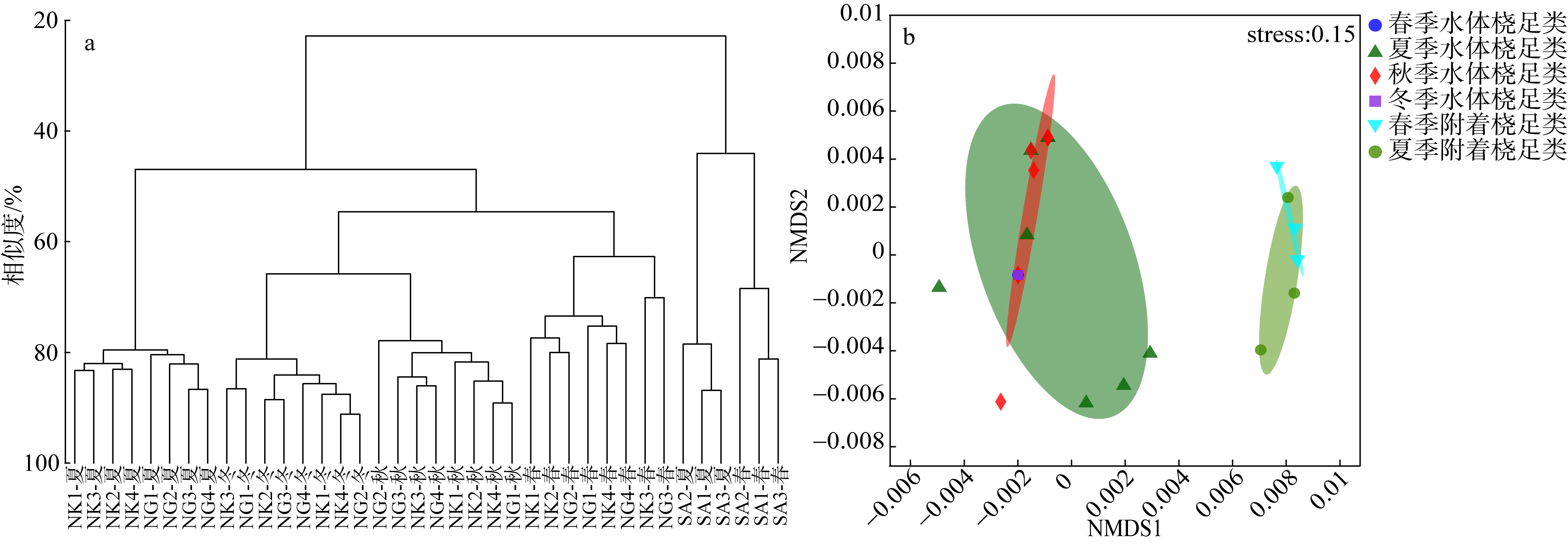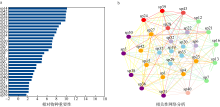热带海洋学报 ›› 2023, Vol. 42 ›› Issue (4): 155-165.doi: 10.11978/2022219CSTR: 32234.14.2022219
广西涠洲岛大型海藻场及其邻近海域桡足类群落结构演替特征
- 1.暨南大学生态学系, 人与自然生命共同体实验室, 南方海洋科学与工程广东省实验室(珠海), 广东 广州 510632
2.中山大学海洋科学学院, 海洋生物资源与环境珠海重点实验室, 广东 珠海 519082
3.广东省海洋资源与近岸工程重点实验室, 广东 珠海 519000
-
收稿日期:2022-10-12修回日期:2022-12-10出版日期:2023-07-10发布日期:2022-12-12 -
作者简介:郭键林(1997—), 男, 广东省梅州市人, 硕士研究生, 从事浮游动物生态学研究。email: 897363730@qq.com
-
基金资助:南方海洋科学与工程广东省实验室(珠海)资助项目(SML2021SP203); 国家自然科学基金面上项目(41977268); 国家自然科学基金面上项目(32271684)
The succession characteristics of copepod community structure in the seaweed bed and its adjacent waters in the Weizhou Island, Guangxi Province
GUO Jianlin1( ), SUN Xian2,3, YANG Yufeng1, WANG Qing1(
), SUN Xian2,3, YANG Yufeng1, WANG Qing1( )
)
- 1. Department of Ecology, Key Laboratory of Philosophy and Social Science in Guangdong Province Jinan University, Southern Marine Science and Engineering Guangdong Laboratory (Zhuhai), Guangzhou 510632, China
2. School of Marine Sciences, Zhuhai Key Laboratory of Marine Bioresources and Environment, Sun Yat-sen University, Zhuhai 519082, China
3. Guangdong Provincial Key Laboratory of Marine Resources and Coastal Engineering, Zhuhai 519000, China
-
Received:2022-10-12Revised:2022-12-10Online:2023-07-10Published:2022-12-12 -
Supported by:Southern Marine Science and Engineering Guangdong Laboratory (Zhuhai)(SML2021SP203); National Natural Science Foundation of China(41977268); National Natural Science Foundation of China(32271684)
摘要:
于2021年7月和11月、2022年1月和4月对广西涠洲岛大型海藻场及其邻近海域的桡足类及其休眠卵进行了调查。在水体中共鉴定出桡足类43种, 优势种为锥形宽水蚤(Temora turbinata)、微刺哲水蚤(Canthocalanus pauper)、强额拟哲水蚤(Pavocalanus crassirostris)等哲水蚤, 平均丰度为(105±22)ind·m-3; 大型海藻藻体附着桡足类10种, 优势种为尖额谐猛水蚤(Euterpina acutifrons)、硬鳞暴猛水蚤(Clytemnestra scutellata)、小毛猛水蚤(Microsetella norvegica)等猛水蚤, 平均丰度为(1.17±0.16)×105ind·m-3, 藻体附着桡足类丰度远高于水体中桡足类丰度(P<0.01); 沉积物中桡足类休眠卵平均丰度为(171±55)×104ind·m-3, 平均潜在补充量为(109±40)×104ind·m-3, 平均萌发率为64%±6%。在马尾藻生长茂盛期(4月), 表层沉积物中休眠卵丰度、潜在补充量与萌发率显著高于其他季节(P<0.05)。调查表明, 研究海域桡足类具有较高的均匀度(0.88)和物种多样性(2.66)。随机森林模型与相关性网络分析均显示, 涠洲岛海域桡足类的优势种微刺哲水蚤重要性较高, 且与其他物种关系紧密。马尾藻生长促进休眠卵萌发, 导致水体中桡足类丰度增高, 藻体附着桡足类丰度随水体桡足类丰度增加而升高。马尾藻的生长和凋落过程是涠洲岛海藻场生态系统中桡足类群落结构演变的重要驱动因素。
引用本文
郭键林, 孙显, 杨宇峰, 王庆. 广西涠洲岛大型海藻场及其邻近海域桡足类群落结构演替特征[J]. 热带海洋学报, 2023, 42(4): 155-165.
GUO Jianlin, SUN Xian, YANG Yufeng, WANG Qing. The succession characteristics of copepod community structure in the seaweed bed and its adjacent waters in the Weizhou Island, Guangxi Province[J]. Journal of Tropical Oceanography, 2023, 42(4): 155-165.
表1
涠洲岛水体和马尾藻藻体附着桡足类优势种及优势度"
| 种类 | 优势度 | 备注 | ||||||
|---|---|---|---|---|---|---|---|---|
| 春季 | 夏季 | 秋季 | 冬季 | 春季藻体附着 | 夏季藻体附着 | |||
| 红纺缍水蚤 | Acartia erythraea | 0.04 | / | 0.08 | / | / | / | sp1 |
| 丹氏纺缍水蚤 | Acartia danae | 0.02 | / | / | / | / | / | sp2 |
| 太平洋纺锤水蚤 | Acartia pacifica | / | / | / | 0.05 | / | / | sp26 |
| 驼背隆哲水蚤 | Acrocalanus gibber | / | 0.03 | 0.04 | / | / | / | sp17 |
| 微驼背隆哲水蚤 | Acrocalanus gracilis | 0.02 | / | / | / | / | / | sp18 |
| 小纺缍水蚤 | Acartia negligens | / | / | / | 0.04 | / | / | sp29 |
| 矮隆哲水蚤 | Bestiolina amoyensis | 0.02 | 0.10 | / | 0.03 | / | / | sp31 |
| 中华哲水蚤 | Calanus sinicus | 0.07 | / | 0.10 | 0.14 | / | 0.04 | sp7 |
| 微刺哲水蚤 | Canthocalanus pauper | 0.12 | 0.06 | 0.26 | 0.13 | 0.02 | / | sp15 |
| 奥氏胸刺水蚤 | Centropages orsinii | 0.02 | / | / | / | / | / | sp25 |
| 瘦尾胸刺水蚤 | Centropages tenuiremis | / | 0.26 | / | 0.04 | / | 0.21 | sp24 |
| 椭形长足水蚤 | Calanopia elliptica | 0.06 | / | 0.18 | 0.36 | / | / | sp30 |
| 硬磷暴猛水蚤 | Clytemnestra scutellata | / | / | / | / | 0.13 | 0.15 | sp6 |
| 尖额谐猛水蚤 | Euterpina acutifrons | 0.02 | 0.29 | 0.10 | / | 0.30 | 0.38 | sp5 |
| 亚强真哲水蚤 | Eucalanus subcrassus | / | 0.04 | / | / | / | / | sp12 |
| 精致真刺水蚤 | Euchaeta concinna | / | 0.03 | 0.15 | 0.24 | 0.02 | / | sp32 |
| 小毛猛水蚤 | Microsetella norvegica | 0.02 | 0.05 | 0.05 | / | 0.13 | 0.04 | sp4 |
| 丽隆剑水蚤 | Oncaea venusta | 0.05 | 0.05 | / | / | / | / | sp37 |
| 拟长腹剑水蚤 | Oithona similis | 0.06 | 0.27 | / | / | / | / | sp38 |
| 坚长腹剑水蚤 | Oithona rigida | / | / | / | / | 0.02 | / | sp39 |
| 等刺隆剑水蚤 | Oncaea mediterranea | 0.02 | 0.10 | / | 0.05 | / | / | sp36 |
| 强额拟哲水蚤 | Pavocalanuscrassirostris | 0.05 | 0.07 | 0.04 | 0.04 | / | / | sp16 |
| 小拟哲水蚤 | Paracalanus parvus | / | 0.03 | 0.08 | / | / | / | sp11 |
| 瘦拟哲水蚤 | Paracalanus gracilis | / | 0.05 | 0.07 | 0.18 | / | / | sp34 |
| 黑点叶剑水蚤 | Sapphirina nigromaculata | 0.05 | / | / | / | / | / | sp33 |
| 瘦歪水蚤 | Tortanus gracilis | / | / | 0.07 | / | / | / | sp27 |
| 异尾宽水蚤 | Temora discaudata | 0.06 | / | 0.10 | / | / | / | sp23 |
| 锥形宽水蚤 | Temora turbinata | 0.08 | 0.17 | 0.12 | 0.12 | 0.10 | / | sp22 |
| 普通波水蚤 | Undinula vulgaris | 0.07 | / | 0.04 | 0.05 | / | / | sp21 |
表2
涠洲岛水体桡足类的物种多样性指数(H')和均匀度(J)"
| 站位 | NK1 | NK2 | NK3 | NK4 | NG1 | NG2 | NG3 | NG4 | |
|---|---|---|---|---|---|---|---|---|---|
| 春季 | J | 0.88 | 0.79 | 0.85 | 0.82 | 0.86 | 0.86 | 0.83 | 0.87 |
| H' | 2.50 | 2.23 | 2.24 | 2.22 | 2.50 | 2.14 | 2.36 | 2.56 | |
| 夏季 | J | 0.86 | 0.88 | 0.86 | 0.88 | 0.85 | 0.89 | 0.87 | 0.89 |
| H' | 2.69 | 2.71 | 2.65 | 2.60 | 2.60 | 2.71 | 2.60 | 2.85 | |
| 秋季 | J | 0.94 | 0.92 | 0.90 | 0.93 | 0.90 | 0.91 | 0.91 | 0.91 |
| H' | 2.82 | 2.81 | 2.75 | 2.79 | 2.61 | 2.63 | 2.74 | 2.72 | |
| 冬季 | J | 0.90 | 0.90 | 0.87 | 0.87 | 0.87 | 0.87 | 0.88 | 0.92 |
| H' | 2.81 | 2.78 | 2.51 | 2.61 | 2.74 | 2.57 | 2.76 | 2.65 | |
| [1] |
陈亮东, 栾磊磊, 王庆, 等, 2015. 珠江口桂山岛海域桡足类休眠卵对浮游种群的潜在补充及其影响因素[J]. 生态学报, 35(10): 3373-3381.
|
|
|
|
| [2] |
龚玉艳, 张才学, 陈作志, 等, 2015. 湛江湾浮游动物群落结构特征及其周年变化[J]. 海洋科学, 39(12): 46-55.
|
|
|
|
| [3] |
何本茂, 黎广钊, 韦蔓新, 等, 2013. 涠洲岛珊瑚礁海域氮磷比值季节变化与浮游生物结构的关系[J]. 热带海洋学报, 32(4): 64-72.
doi: 10.11978/j.issn.1009-5470.2013.04.010 |
|
|
|
| [4] |
姜晓东, 王桂忠, 李少菁, 等, 2004. 厦门港桡足类卵库对其浮游种群潜在补充量的初步研究[J]. 厦门大学学报, 43(2): 233-236.
|
|
|
|
| [5] |
李开枝, 柯志新, 王军星, 等, 2022. 西沙群岛珊瑚礁海域浮游动物群落结构初步分析[J]. 热带海洋学报, 41(2): 121-131.
doi: 10.11978/2021036 |
|
|
|
| [6] |
李开枝, 任玉正, 柯志新, 等, 2021. 南海东北部陆坡区中上层浮游动物的垂直分布[J]. 热带海洋学报, 40(2): 61-73.
doi: 10.11978/2020061 |
|
|
|
| [7] |
梁淼, 姜倩, 孙丽艳, 等, 2018. 曹妃甸近岸海域大、中型浮游动物优势种空间生态位研究[J]. 生态环境学报, 27(7): 1241-1250.
doi: 10.16258/j.cnki.1674-5906.2018.07.007 |
|
|
|
| [8] |
廖秋香, 尤明双, 刘旭, 2012. 涠洲岛近海近30年气候变化特征浅析[J]. 气象研究与应用, 33(1): 140-141.
|
|
|
|
| [9] |
马林, 李新正, 2015. 我国海洋底栖猛水蚤目两个新记录种[J]. 海洋与湖沼, 46(6): 1321-1325.
|
|
|
|
| [10] |
庞碧剑, 蓝文陆, 黎明民, 等, 2019. 北部湾近岸海域浮游动物群落结构特征及季节变化[J]. 生态学报, 39(19): 7014-7024.
|
|
|
|
| [11] |
任玉正, 柯志新, 谭烨辉, 等, 2020. 广东省南澳岛东部海域浮游动物群落结构及其影响因素[J]. 热带海洋学报, 39(2): 65-76.
doi: 10.11978/2019051 |
|
doi: 10.11978/2019051 |
|
| [12] |
王雁, 吕冬伟, 田雨, 等, 2020. 大型海藻, 海草在生态养殖中的作用及在海洋牧场中的应用[J]. 湖北农业科学, 59(4): 124-128.
|
|
|
|
| [13] |
杨宇峰, 宋金明, 林小涛, 等, 2005. 大型海藻栽培及其在近海环境的生态作用[J]. 海洋环境科学, 24(3): 77-80.
|
|
|
|
| [14] |
张才学, 龚玉艳, 王学锋, 等, 2011. 湛江港湾浮游桡足类群落结构的季节变化和影响因素[J]. 生态学报, 31(23): 7086-7096.
|
|
|
|
| [15] |
张才学, 周伟男, 孙省利, 等, 2020. 硇洲岛大型海藻群落的季节演替[J]. 热带海洋学报, 39(1): 74-84.
doi: 10.11978/2019026 |
|
doi: 10.11978/2019026 |
|
| [16] |
张才学, 周凯, 孙省利, 等, 2010. 深圳湾浮游动物的群落结构及季节变化[J]. 生态环境学报, 19(11): 2686-2692.
doi: 10.16258/j.cnki.1674-5906(2010)11-2686-07 |
|
|
|
| [17] |
郑惠东, 2009. 福建东山湾浮游动物的种类组成与数量分布特点[J]. 渔业研究, (2): 11-17.
|
|
|
|
| [18] |
邹琦, 吴志强, 黄亮亮, 等, 2020. 广西涠洲岛珊瑚礁海域鱼类物种组成的调查分析[J]. 南方农业学报, 51(1): 1-10.
|
|
|
|
| [19] |
|
| [20] |
doi: 10.3897/BDJ.8.e53818 |
| [21] |
doi: 10.1111/mec.14496 pmid: 29368406 |
| [22] |
doi: 10.1016/S0924-7963(97)00025-0 |
| [23] |
doi: 10.1111/j.1365-2656.2008.01501.x pmid: 19021779 |
| [24] |
doi: 10.3844/ajessp.2015.450.473 |
| [25] |
|
| [26] |
doi: 10.3354/meps061159 |
| [27] |
doi: 10.1016/j.ecss.2010.12.032 |
| [28] |
doi: 10.1007/BF00349273 |
| [29] |
|
| [30] |
doi: 10.3897/BDJ.9.e67449 |
| [31] |
doi: 10.1098/rstb.2008.0335 |
| [32] |
doi: 10.1007/BF00349225 |
| [33] |
doi: 10.1007/s00227-015-2632-x |
| [34] |
doi: 10.1111/are.12471 |
| [35] |
doi: 10.1007/s00227-002-0893-7 |
| [36] |
|
| [37] |
doi: 10.1016/S0025-326X(97)00115-X |
| [38] |
doi: 10.1007/s10750-010-0421-6 |
| [39] |
|
| [40] |
doi: 10.2307/1938197 |
| [41] |
|
| [42] |
doi: 10.1016/j.csr.2016.04.007 |
| [43] |
|
| [44] |
|
| [45] |
doi: 10.1086/284379 |
| [46] |
doi: 10.1016/j.scitotenv.2017.03.233 |
| [47] |
doi: 10.1016/j.algal.2015.03.017 |
| [1] | 王佳熹, 卢护木, 齐鑫, 高程海, 刘永宏, 罗小卫. 涠洲岛鹿角珊瑚共附生真菌Arachniotus ruber GXIMD 02510的次级代谢产物及抑菌活性研究[J]. 热带海洋学报, 2024, 43(4): 174-180. |
| [2] | 邢楠楠, 任润馨, 唐振洲, 罗志宏, 夏辰曦, 刘永宏, 彭亮, 陈显强. 涠洲岛海洋沉积物来源真菌Aspergillus sp. GXIMD02003的代谢产物研究[J]. 热带海洋学报, 2023, 42(5): 154-160. |
| [3] | 李开枝, 任玉正, 柯志新, 李刚, 谭烨辉. 南海东北部陆坡区中上层浮游动物的垂直分布*[J]. 热带海洋学报, 2021, 40(2): 61-73. |
| [4] | 张婷, 胡敏航, 张文静, 陈天然, 刘猛. 涠洲岛珊瑚礁近千年的发育过程及其对气候变化的响应*[J]. 热带海洋学报, 2020, 39(4): 70-79. |
| [5] | 江丽春, 李群, 吕颂辉. 广西涠洲岛底栖甲藻前沟藻属(Amphidinium)种类的形态学和系统发育学研究[J]. 热带海洋学报, 2020, 39(3): 106-115. |
| [6] | 何学佳, 杨华明, 吕柏东, 尹健强. 核酸指标对桡足类安氏伪镖水蚤摄食率、生长率及产卵率的指示作用[J]. 热带海洋学报, 2018, 37(2): 26-35. |
| [7] | 何学佳, 韩留玉, 吕柏东, 王小冬, 尹健强. 核酸指标对安氏伪镖水蚤生长率的指示作用饵料转换的响应[J]. 热带海洋学报, 2015, 34(4): 65-73. |
| [8] | 李健鹏, 赵素芬, 孙会强, 刘东超, 李海娟, 李国荣. 盐度对灰叶马尾藻排卵及幼孢子体早期发育的影响[J]. 热带海洋学报, 2014, 33(1): 97-104. |
| [9] | 陈天然, 郑兆勇, 莫少华, 周雄, 陈特固. 涠洲岛滨珊瑚骨骼生长率变化对气候变暖和极端事件增加的响应[J]. 热带海洋学报, 2013, 32(5): 79-84. |
| [10] | 何本茂, 黎广钊, 韦蔓新, 谭趣孜. 涠洲岛珊瑚礁海域氮磷比值季节变化与浮游生物结构的关系[J]. 热带海洋学报, 2013, 32(4): 64-72. |
| [11] | 李开枝, 谭烨辉, 黄良民, 尹健强, 宋星宇, 张建林. 珠江口浮游桡足类摄食研究[J]. 热带海洋学报, 2012, 31(6): 90-96. |
| [12] | 江志兵,曾江宁,陈全震,廖一波,高爱根,徐晓群,寿鹿,. 不同升温速率对桡足类高起始致死温度的影响[J]. 热带海洋学报, 2010, 29(3): 87-92. |
|
||

















